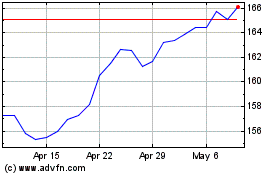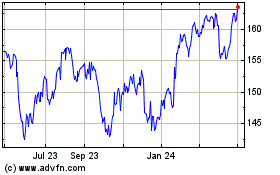By Josh Mitchell
The U.S. economy stumbled during the first months of the year,
as consumers reined in spending despite a rise in household
confidence and a surge in stock prices that greeted the
inauguration of President Donald Trump.
Gross domestic product, a broad measure of national output, grew
at a 0.7% annual rate in January through March, the slowest pace of
expansion in three years, the Commerce Department said Friday.
Americans sharply cut back spending on big-ticket items like cars,
causing overall consumer purchases to grow at the slowest pace
since late 2009.
Major makers of household staples including Procter & Gamble
Co. and PepsiCo Inc. this week reported lackluster sales due partly
to weak consumer spending. Car maker Ford Motor Co. posted a 35%
drop in first-quarter profit. Online retailer Amazon.com Inc. was a
bright spot, reporting a jump in profit.
Temporary factors may have suppressed consumer spending in the
first quarter. The economy also has a habit of starting the
calendar year slowly and then picking up speed in the spring and
summer.
The report offered hopeful signs of stronger growth in the
coming months, with U.S. companies stepping up investment in
long-term projects.
"If you look at the backdrop for spending, including [rising]
income, wealth, as well as confidence, I think it's pretty clear
the trend in consumer spending has not suddenly collapsed," said
Jim O'Sullivan, chief U.S. economist at High Frequency
Economics.
Still, the GDP report was a stark reminder that Mr. Trump has
set out to reach a daunting goal. The economy has expanded at an
anemic annual rate of 2% since 2000 -- including the effects of two
recessions. Mr. Trump and his advisers have vowed to boost the
growth rate to 3% or more. They are up against long-running
headwinds that won't be easily reversed, including an aging
population and weak productivity growth.
The latest figures offered the broadest report card on the
economy's performance in the first 100 days of the Trump
administration. Few presidents have entered office with the kind of
expectations facing Mr. Trump. Confidence among consumers and
businesses hit multiyear highs and the stock markets hit record
levels in the first quarter.
Economists say it is far too early to judge the president's
impact on the economy, especially given that he hasn't put in place
the main components of his economic plans -- a broad tax overhaul
which dramatically reduces corporate tax rates, revamped trade
deals and a rollback of environmental, labor, health and other
regulations.
"Business and consumer sentiment is strong, but both must be
released from the regulatory and tax shackles constraining economic
growth," Commerce Secretary Wilbur Ross said in a statement after
the GDP report.
Most economists expect growth to rebound to a rate of between 3%
and 4% this quarter and then to settle back into its 2% trend in
the months ahead.
Sluggish consumer spending drove the first-quarter slowdown,
presenting the biggest puzzle of the economy this year. With
confidence and stock prices high, gasoline prices modest and jobs
and wages increasing, spending ought to be picking up.
Economists have several theories for why that didn't happen. The
unusually warm winter led Americans to spend less than usual on
heating their homes, meaning less output from big utilities. And
delays in many Americans receiving tax refunds from the Internal
Revenue Service may have left them with less spending money
relative to prior years.
Still, those theories don't entirely explain why consumer
spending on durable goods, such as cars and refrigerators, fell by
the most in nearly six years.
Concerns are building in the car industry, where a seven-year
run in sales growth appears to be petering out. Car sales likely
declined for the fourth straight month in April, despite discounts
and incentives increasingly pitched by car makers, industry data
show.
Strong auto sales have helped boost the economy in recent
years.
"Clearly it's a more competitive market that we're dealing in
than it was two or three years ago," General Motors Co. finance
chief Chuck Stevens told reporters Friday, adding that the
"industry is plateauing."
Car dealers were sitting on a 72-day supply of vehicles on
average in March, up from 66 days a year earlier, according to
researcher WardsAuto.com. Vehicles are piling up despite bigger
discounts. Car makers spent an average of $3,499 on incentives per
vehicle in the first half of April, the highest level for the month
since 2009, according to J.D. Power.
Indeed, a drawdown in inventories across the economy had a big
negative effect on growth last quarter. Instead of placing new
orders with manufacturers, many companies whittled down their
stockpiles. The lack of inventory investment dragged down the
overall growth in GDP by nearly a full percentage point.
That could reverse if consumer spending picks up, providing a
boost to output in the months ahead.
Still, other retailers this week expressed concern about
consumers. Nestlé Chief Executive Mark Schneider on an investor
call pointed to "fairly soft demand even in the face of pretty good
fundamental economic data." He said that might have to do with
lingering uncertainty, but that he remains optimistic about the
rest of the year.
Government spending also fell in the first quarter, though those
drops might be temporary. One possible factor: A three-month hiring
freeze imposed by the Trump administration that was recently
lifted. Declines in defense spending, which can vary greatly
quarter to quarter, and state and local government spending could
reverse later this year.
Perhaps the most encouraging sign from Friday's report is a
pickup in business investment. Throughout most of the recovery,
companies have largely put off building new factories and
purchasing equipment. Those are the kinds of projects that make
companies more efficient, boost worker productivity and, over the
long haul, lift economic growth.
Such spending grew at a 9.4% rate last quarter, the fastest
since late 2013. That coincides with surveys showing surging
confidence among businesses following Mr. Trump's November election
victory. Investment picked up broadly, but the biggest factor was a
pickup in mining-related structures, reflecting a rebound in the
energy industry that has led to renewed drilling and exploration
projects.
Jason Furman, a Peterson Institute senior fellow who served as
former President Barack Obama's top economic adviser, called the
investment figures "exciting to see" after years of waiting for
such an increase. "Maybe that rebound is finally here," he
said.
Arrowsight Inc. says it has seen a rise in investment spending
from clients. The Mount Kisco, N.Y.-based firm sells video-camera
software to monitor business facilities for quality control. It has
seen a bump in sales in recent months in the food industry,
particularly among meat producers seeking to improve food safety
and animal welfare, said Adam Aronson, the closely held company's
chief executive officer.
"Typically when you see very big companies that are investing in
things like that, it means that they're doing quite well," Mr.
Aronson said. "In tougher times, those are nice to have -- not
necessarily things that you would progressively invest in as much
as we're seeing."
--Mike Colias contributed to this article.
Write to Josh Mitchell at joshua.mitchell@wsj.com
(END) Dow Jones Newswires
April 28, 2017 17:43 ET (21:43 GMT)
Copyright (c) 2017 Dow Jones & Company, Inc.
Procter and Gamble (NYSE:PG)
Historical Stock Chart
From Mar 2024 to Apr 2024

Procter and Gamble (NYSE:PG)
Historical Stock Chart
From Apr 2023 to Apr 2024
